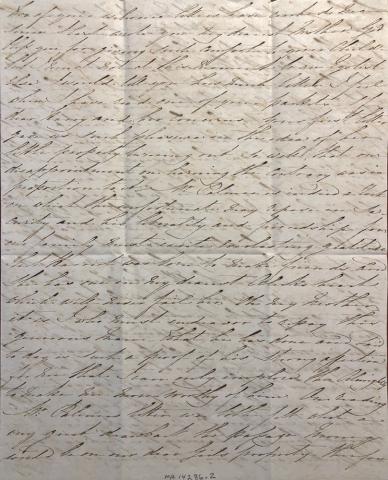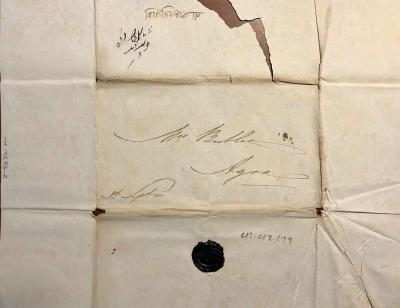This is a guest post by Sam Bussan, a PhD student in the Department of History at the Graduate Center, CUNY.

MA 14286.2, autograph letter signed from Maria Knox, Nasirabad, India, to Mrs. Harriet Butler, 1819 September 3, page 1.
I spent this summer at the Morgan working with the Literary & Historical Manuscripts Department to catalog the Maria Knox Letters. This collection of sixty-three letters, almost exactly two centuries old, records the life of a British family in India from 1816 to 1822. They are named for Maria Knox (1795–1822) who wrote 59 of the letters to her mother, Mrs. Harriet Butler (1770–1847, previously Becher). Maria was born somewhere in Bengal, British India, to John Harman Becher, an official in the British East India Company, and his wife. Like many British children born in India, Maria and her two sisters were sent back to England for their education, living with their maternal grandmother and aunt in Somerset. She returned to India in 1814 and there married Colonel Alexander Knox. The two lived in the military town of Nasirabad, in what is now the state of Rajasthan. Her mother, by this point widowed and remarried to Captain Edward William Butler, lived in the city of Agra in what is now Uttar Pradesh.
Maria was in poor health for most of her life, and her condition became markedly worse when she returned to the subcontinent. Her health is the most consistent topic of discussion in the letters. Her couch appears as the place of convalescence, to which she was frequently confined due to weakness. Besides weakness, her symptoms included headaches, stomach pains, and vomiting. They reached a crisis during her pregnancy in 1821–22, ultimately causing her death on May 28, 1822.
The Maria Knox Letters provide a uniquely intimate look at private life in the Georgian tropics. This was a place that colonizers from Georgian Britain (1714–1837) created, geographically, socially, culturally, intellectually, and scientifically. It reflected the collision of a certain set of ideas and values with the difficult reality of living on the edge of the imperial project. In their attempts to reshape their world, the British also reshaped themselves. This has been noted by historians of health (notably David Arnold and Mark Harrison), the family (such as Ronald Hyam and Ann Stoler), and community.
The letters express the isolation of British colonizers’ lives. The tiny British minority attempted to separate itself from Indian society, which was all around them. In reality, none of them could survive without innumerable Indian servants and subordinates. Their state of denial about this dependence shows that the isolation Maria Knox discussed was mentally and socially constructed. Reactively, the bonds between British families became extremely strong. This was especially true of British women like Maria and her friends, whose numbers were very small in the early-nineteenth-century India.
Though they were not really isolated from the society that they tried to rule, British people were isolated from their home country by long distance and difficult communication. Letters took five months by sea to get between Britain and India, leaving British colonizers with little knowledge of the immediate situation at home. Even the distances between different parts of British India could be frustrating. Letters from Maria to her mother took weeks to arrive. When her mother travelled from Kolkata to Nasirabad during her daughter’s final illness, Maria lamented the difficulty of the journey during the winter months. These distances—between India and Britain and between herself and her mother within India—were a consistent source of emotional pain for Maria.
Maria’s extensive discussion of her illness (which is never definitively identified) contains important information for the history of health in the British Empire. It is informative to read about both her symptoms and her way of thinking about them. As Mark Harrison writes in his excellent book Climates and Constitutions, the tropics were a place of dreadful illness for the Georgian British. The primitive state of European medicine meant that tropical diseases like malaria were a regular part of life for the British colonizers and were often debilitating or fatal. Because of the state of medicine at this time, they thought very differently about health than people in the present. Their ideas about the causes of disease, concerned with the body’s balance, are quite foreign to us. The unfamiliar conditions in the tropics, they thought, disturbed the European body. They also did not possess our confidence that medical science could help them. Though Maria’s social circle included multiple doctors, her letters show that she really trusted only in providence to preserve her.
 Sam Bussan is a PhD student in the Department of History at the Graduate Center, CUNY. His research is on the histories of psychology and psychiatry in modern Britain.
Sam Bussan is a PhD student in the Department of History at the Graduate Center, CUNY. His research is on the histories of psychology and psychiatry in modern Britain.


